
British coins on this page are arranged from the most valuable to the least valuable, and they are also shown in four major groups. As a general rule, coins closer to the top of the page, and coins closer to the top of a group, command higher values than coins in lower positions. Some coins derive value from their pristine state of preservations (called uncirculated coins), and heavily worn or damaged coins are always worth less than specimens showing average wear.
Look up individual coins using the search functions on this web site. This page gives general values for the most common types.
Coins from Great Britian do not always bear insriptions that identify their origin. Inscriptions of BRITT, BRITANNIA, BRITTANNIARUM or of British rulers ANNE, GEORGE, WILLIAM, VICTORIA, EDWARD, and ELIZABETH, often with DEI GRATIA (by the grace of God) usually indicate British origins.
Dating British coins can sometimes be a problem. Use this list of British monarchs to get an idea of date when no date appears explicitly on the coin.
Likewise, British coins do not always bear inscriptions that identify their monetary value, relying on size, pattern and composition to convey this information. The monetary system before 1970 is a complicated combination of the following denominations: Farthing, Pence (one pence is called a Penny, four pence is called a groat), Shilling, Florin, Crown, Sovereign (also called a Pound), and Guinea.
Coins in this group range in value from thousands of dollars down to hundreds of dollars. Unless they are heavily worn or have significant damage like scratches, spots, or stains, these coins command high premium values and must be treated with care. Never clean a coin. Cleaning ruins value.
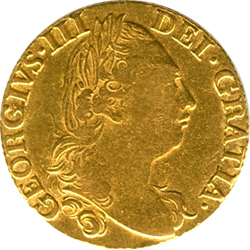 Early Large-Sized Guineas - There are many different varieties of early British gold guineas. Most look similar to the coin in the picture, but there are many variations. All command high value from their gold content and intrinsic age and beauty. Small-sized guineas, such as half guineas, quarter guineas, and one-third guineas, and those more modern than the one shown, are worth less, but are still quite valuable. The coin in the picture has George III, 1760 to 1820. It comes from that period and is about the size of a US half dollar. It is worth about $1000.
Early Large-Sized Guineas - There are many different varieties of early British gold guineas. Most look similar to the coin in the picture, but there are many variations. All command high value from their gold content and intrinsic age and beauty. Small-sized guineas, such as half guineas, quarter guineas, and one-third guineas, and those more modern than the one shown, are worth less, but are still quite valuable. The coin in the picture has George III, 1760 to 1820. It comes from that period and is about the size of a US half dollar. It is worth about $1000.
 Massive British Gold - Some gold coins from Great Britain are quite large, often containing more than one Troy ounce of the precious metal. These derive value from the gold, and some earlier coins, such as 5 pound gold coins from the early 1800s, climb in value to the $10,000 range.
Massive British Gold - Some gold coins from Great Britain are quite large, often containing more than one Troy ounce of the precious metal. These derive value from the gold, and some earlier coins, such as 5 pound gold coins from the early 1800s, climb in value to the $10,000 range.
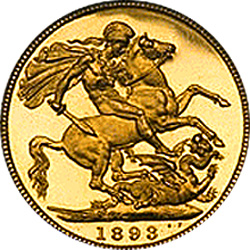 Many British Proof Sets - About one half of the dates for British Proof Sets are extraordinarily valuable. Sets before 1911 command 1000s of dollars, sometimes 10s of 1000s of dollars for sets and individual coins that are completely unspoiled. More modern dates for intact proof sets that are very valuble are 1927, 1937, and certain sets (not all sets) after 1982.
Many British Proof Sets - About one half of the dates for British Proof Sets are extraordinarily valuable. Sets before 1911 command 1000s of dollars, sometimes 10s of 1000s of dollars for sets and individual coins that are completely unspoiled. More modern dates for intact proof sets that are very valuble are 1927, 1937, and certain sets (not all sets) after 1982.
 Early Sovereigns Before Queen Victoria - Gold coins are always valuable, and sovereigns and half-sovereigns with shield and dragon slayer designs are especially sought by collectors. These coins are about the size of a US quarter dollar. Earlier coins are more valuable.
Early Sovereigns Before Queen Victoria - Gold coins are always valuable, and sovereigns and half-sovereigns with shield and dragon slayer designs are especially sought by collectors. These coins are about the size of a US quarter dollar. Earlier coins are more valuable.
Coins in this group range in value from hundreds of dollars down to a few tens of dollars, unless, like all coins, they are heavily worn or have significant damage like scratches, spots, or stains. Never clean a coin. Cleaning ruins value. There are several varieties of many of these coins.
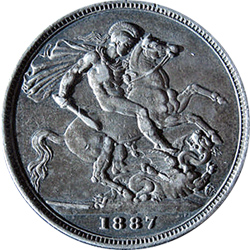 Large Early Silver Florins and Crowns - Florins (two shillings), double florins, crowns (five shillings), and half crowns are generally large and made of silver. They command good value based on precious metal content, age, and artistry. They date back into the 1600s and those, no surprise, are the most valuable. Use the list of British rulers above to help determine date. Modern (post 1940) versions of these coins are usually made of non-precious metal and carry little value. Most coins dated before 1800 are quite valuable. Post-1800 dates that command strong value are 1854 Florin, 1823 half crown, 1905 half crown, and 1831, 1847, and 1934 crowns.
Large Early Silver Florins and Crowns - Florins (two shillings), double florins, crowns (five shillings), and half crowns are generally large and made of silver. They command good value based on precious metal content, age, and artistry. They date back into the 1600s and those, no surprise, are the most valuable. Use the list of British rulers above to help determine date. Modern (post 1940) versions of these coins are usually made of non-precious metal and carry little value. Most coins dated before 1800 are quite valuable. Post-1800 dates that command strong value are 1854 Florin, 1823 half crown, 1905 half crown, and 1831, 1847, and 1934 crowns.
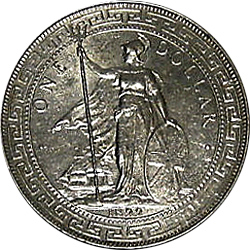 Britannia Trade Coins and Tokens - Great Britain issued coins to facilitate trade in some of its far flung empire around the world. Many of these coins, especially the large silver ones, are valuable.
Britannia Trade Coins and Tokens - Great Britain issued coins to facilitate trade in some of its far flung empire around the world. Many of these coins, especially the large silver ones, are valuable.
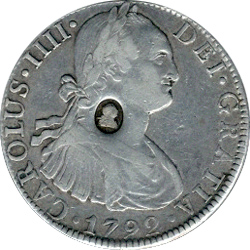 Counterstamped Non-British Issues - In some coin shortage emergencies, the Bank of England counterstamped small insignia in foreign coins and made them legal tender in the British Empire. Early counterstamps, like the one shown in this picture, are shaped like an oval. Later counterstamps are rectangles with cut off corners. All these coins are usually quite valuable. The older, the more valuable. The coin in the picture comes from colonial Mexico. It is counterstamped with a Bank of England puncheon from 1797.
Counterstamped Non-British Issues - In some coin shortage emergencies, the Bank of England counterstamped small insignia in foreign coins and made them legal tender in the British Empire. Early counterstamps, like the one shown in this picture, are shaped like an oval. Later counterstamps are rectangles with cut off corners. All these coins are usually quite valuable. The older, the more valuable. The coin in the picture comes from colonial Mexico. It is counterstamped with a Bank of England puncheon from 1797.
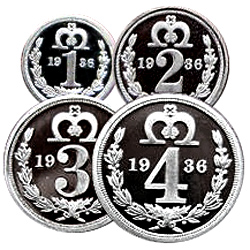 Maundy Sets - The earlier Maundy Sets are worth far more than recent ones. They date back into the 1600s. Typical modern sets catalog in the $100 range; sets before 1800 climb towards $500. Maundy sets are special ceremonial issues struck each year for the traditional ceremony on Maundy Thursday. The most value comes when the original packaging is intact.
Maundy Sets - The earlier Maundy Sets are worth far more than recent ones. They date back into the 1600s. Typical modern sets catalog in the $100 range; sets before 1800 climb towards $500. Maundy sets are special ceremonial issues struck each year for the traditional ceremony on Maundy Thursday. The most value comes when the original packaging is intact.
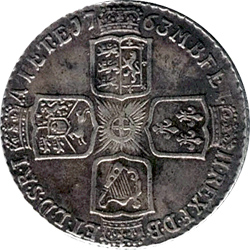 Early Shillings Before George II - Very old shillings are valuable. Modern shillings are not. Shillings with William III, Anne, and George I are the most valuable.
Early Shillings Before George II - Very old shillings are valuable. Modern shillings are not. Shillings with William III, Anne, and George I are the most valuable.
These coins sometimes climb into the $100 range, but most are worth a few dollars or a few tens of dollars. High states of preservation work in your favor; heavy wear and problems work against you. Don't worry if your coin does not look exactly like the one pictured.
 Small British Copper before 1800 - Farthings, quarter farthings, one-third farthings, half farthings, and half pennys before 1800 are fairly valuable. These have the seated female figure shown in the picture.
Small British Copper before 1800 - Farthings, quarter farthings, one-third farthings, half farthings, and half pennys before 1800 are fairly valuable. These have the seated female figure shown in the picture.
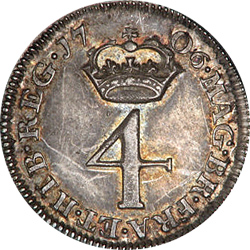 Small British Silver before 1800 - Pennys and pence before 1800 are small silver coins which were ultimately replaced by copper starting in 1797. They are fairly valuable. They range in size from that of a US dime to that of a US quarter dollar. Twelve pence equals one shilling, and coins with denominations of 1, 2, 3, and 4 pence carry the corresponding number on the reverse.
Small British Silver before 1800 - Pennys and pence before 1800 are small silver coins which were ultimately replaced by copper starting in 1797. They are fairly valuable. They range in size from that of a US dime to that of a US quarter dollar. Twelve pence equals one shilling, and coins with denominations of 1, 2, 3, and 4 pence carry the corresponding number on the reverse.
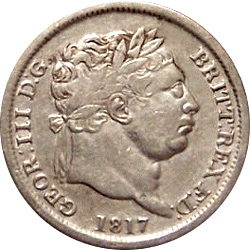 Six Pence, especially from 1838 to 1866 and 1893 - All but the most modern (post 1940s) six pence coins are minted in silver and are fairly large, about the size of a US quarter. These coins carry modest collector value when they are in good condition.
Six Pence, especially from 1838 to 1866 and 1893 - All but the most modern (post 1940s) six pence coins are minted in silver and are fairly large, about the size of a US quarter. These coins carry modest collector value when they are in good condition.
 Large Copper Pennys and Half Pennys - Modern versions are not worth very much, but older, pre-1920 pennys and half pennys are usually worth a few dollars each. A common reverse is shown. Some have a square rigged sailing ship on the reverse. The good dates for regular half pennys are 1845, 1860, and 1871, and the good dates for regular pennys are 1827, 1831, 1834, 1837, 1849, 1869, 1882 without the H mint mark, and 1919 with a KN mint mark. Good dates can climb into the $100s of dollars range. Connaisseurs of British copper track all sorts of minor variations, varieties and departures from the regular strikes, and some of these command strong numismatic premiums. For instance, an 1874 penny comes in a variety known as 17 leaves with thick ribbons. It catalogs for twice as much as the normal 16 leaves variety.
Large Copper Pennys and Half Pennys - Modern versions are not worth very much, but older, pre-1920 pennys and half pennys are usually worth a few dollars each. A common reverse is shown. Some have a square rigged sailing ship on the reverse. The good dates for regular half pennys are 1845, 1860, and 1871, and the good dates for regular pennys are 1827, 1831, 1834, 1837, 1849, 1869, 1882 without the H mint mark, and 1919 with a KN mint mark. Good dates can climb into the $100s of dollars range. Connaisseurs of British copper track all sorts of minor variations, varieties and departures from the regular strikes, and some of these command strong numismatic premiums. For instance, an 1874 penny comes in a variety known as 17 leaves with thick ribbons. It catalogs for twice as much as the normal 16 leaves variety.
 Small British Coins After 1800 - Great Britain issued many different varieties of small copper and silver coins in denominations of one-half, one, one and one-half, two, three, and four pence. Even the older coins minted in the 1800s do not command much collector value today.
Small British Coins After 1800 - Great Britain issued many different varieties of small copper and silver coins in denominations of one-half, one, one and one-half, two, three, and four pence. Even the older coins minted in the 1800s do not command much collector value today.
 Modern Shillings, Florins, Crowns after 1920 - Even though these coins are large, and even though most of them are made of silver, they do not command strong premiums over and above their innate silver value. There are twelve pence in a shilling. Two shillings is called a florin. Double florins are four shillings. A crown is five shillings, and half crown is therefore two and one-half shillings.
Modern Shillings, Florins, Crowns after 1920 - Even though these coins are large, and even though most of them are made of silver, they do not command strong premiums over and above their innate silver value. There are twelve pence in a shilling. Two shillings is called a florin. Double florins are four shillings. A crown is five shillings, and half crown is therefore two and one-half shillings.
Modern issues from Great Britain are worth face value, i.e., the value they have in normal commerce. England has been a member of the European Union since the mid 1970s, but euros were never adopted as currency. Modern pence and pounds circulate freely. Proof coins, which are coins struck especially for collectors and sport mirror-like surfaces, are worth a few dollars more than regular issues. The British Mint also issued modern coins in Mint Sets and Proof Sets. There were made especially for collectors and carry small premium value. When coins are minted in gold or silver, the bullion value applies.
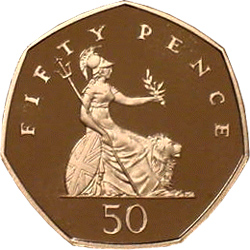 New Pennys and Pence - Decimal coinage replaced the old system in 1971, with 25 new pence in a crown and 100 new pence in a pound. These coins are worth face value unless, like the proof coin pictured, they were minted for collectors. Figure that modern collectible coins lose about one-half of their value as soon as they are purchased from government sources. Coins which come in absolutely uncirculated condition, i.e., found in new bank rolls, carry a small premium for their collector appeal.
New Pennys and Pence - Decimal coinage replaced the old system in 1971, with 25 new pence in a crown and 100 new pence in a pound. These coins are worth face value unless, like the proof coin pictured, they were minted for collectors. Figure that modern collectible coins lose about one-half of their value as soon as they are purchased from government sources. Coins which come in absolutely uncirculated condition, i.e., found in new bank rolls, carry a small premium for their collector appeal.
 Modern Crowns - Like this Charles and Diana piece, are worth face value. Coins which come in absolutely uncirculated condition, i.e., found in new bank rolls, carry a small premium for their collector appeal.
Modern Crowns - Like this Charles and Diana piece, are worth face value. Coins which come in absolutely uncirculated condition, i.e., found in new bank rolls, carry a small premium for their collector appeal.
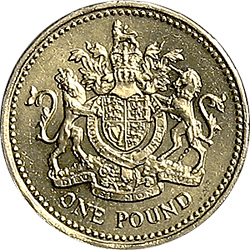 Modern Pounds - These come in several denominations, from 1, 2, 5, 10, 25, 50, to 100 pound coins. Issues over 5 pounds are issued in silver and gold, and therefore carry bullion value. Copper-nickel and nickel-brass issues carry face value.
Modern Pounds - These come in several denominations, from 1, 2, 5, 10, 25, 50, to 100 pound coins. Issues over 5 pounds are issued in silver and gold, and therefore carry bullion value. Copper-nickel and nickel-brass issues carry face value.
About CoinQuest | Privacy Policy | Contact CoinQuest
Copyright 2009 to 2024 CoinQuest.com, all rights reserved.
Daily visitors 217, minutes per visit 5.3, daily coin views 504